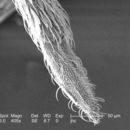en
names in breadcrumbs


Anopheles gambiae is not a single mosquito species, but instead a species complex comprising six species that are morphologically similar but reproductively isolated.
An average person in Africa may experience 50 to 100 Anopheles gambiae bites per night.
Females locate their hosts using a variety of sensory receptors, but respond to movement, carbon dioxide gradients, and sweat. Also, two odorant-binding proteins (OBP) have been isolated in Anopheles gambiae, which are hypothesized to aid female's search for human hosts.
Perception Channels: visual ; tactile ; chemical
US Federal List: no special status
CITES: no special status
Anopheles gambiae development is holometabolous, with four larval instar stages followed by a non-feeding pupal stage where the organism undergoes complete metamorphosis from the larval form to the adult morphology. All mosquito larvae and pupae are aquatic. The larvae eat small pieces of organic matter, while the pupae eat nothing and do not move.
Development - Life Cycle: metamorphosis
In the United States, mosquitoes are often thought of as a pest and a nuisance. Anopheles gambiae is much more than a simple pest, it is responsible for the transmission of malaria and other serious diseases throughout Africa. Anopheles gambiae transmits Plasmodium falciparum, which is the most severe of the four malarial agents. Although this disease was wiped out in the United States, it remains a world health hazard. There are an estimated 300 to 500 million cases of malaria each year and as a result, 1.5 to 2.7 million deaths worldwide. Continental sub-Sahara Africa, however, accounts for roughly 90% of all malarial cases worldwide.
Negative Impacts: injures humans (bites or stings, carries human disease); household pest
Anopheles gambiae have no known positive economic impact on humans.
These mosquitoes are disease vectors, and also provide food to predators.
Ecosystem Impact: parasite
Species Used as Host:
All Anopheles gambiae females are temporary ectoparasites, living in the environment and coming to the host to feed. The females require blood meals to mature their eggs. Males, however, are non-parasitic and feed on plant fluids. Females do not display a tremendous amount of host specificity, but research indicates Anopheles gambiae preferentially feeds on humans. Females locate their hosts using a variety of sensory receptors, but respond to movement, carbon dioxide gradients, and sweat. Also, two odorant-binding proteins (OBP) have been isolated in Anopheles gambiae, which are hypothesized to aid female's search for human hosts.
Animal Foods: blood
Plant Foods: nectar; sap or other plant fluids
Primary Diet: carnivore (Sanguivore ); herbivore (Nectarivore , Eats sap or other plant foods)
The Anopheles gambiae complex is widely distributed throughout Africa.
Biogeographic Regions: ethiopian (Native )
Individuals live throughout Africa, as long as water is readily available. Some species prefer fresh water, while others within the Anopheles gambiae complex live near water with high saline concentrations.
Habitat Regions: temperate ; tropical ; terrestrial ; saltwater or marine ; freshwater
Terrestrial Biomes: savanna or grassland ; forest ; scrub forest
Aquatic Biomes: lakes and ponds; rivers and streams; temporary pools; brackish water
Wetlands: marsh ; swamp ; bog
Other Habitat Features: urban ; suburban ; agricultural ; riparian ; estuarine
Mosquitoes, like all insects, have three body segments: a head, thorax, and abdomen. The thoracic segment possesses three pairs of legs and a pair of wings used for flight. The hind wings are modified into balancing appendages called halteres. Male antennae have significantly more hair like structures, called setae, which aid in locating females. The general coloration of this species is yellowish brown to brown with the last segment of the body normally all dark. The legs are spotted or speckled as an adult, and females normally have three pale bands on their palpi. The wings have pale scales that are creamy white and tinged with yellow. Anopheles gambiae larvae are 5-6 mm long and they are colored in much the same manner as the muddy water in which they are found. They breathe underwater through posterior spiracular plates on the 8th abdominal segment.
Other Physical Features: ectothermic ; heterothermic ; bilateral symmetry
Sexual Dimorphism: sexes colored or patterned differently
Mosquitos are food for many types of birds, bats, frogs, lizards, and spiders.
Adults mate almost immediately after emerging.
Adults mate soon after emerging from their pupae. Females require blood meals to mature their fertilized eggs. Some species in the Anopheles gambiae complex are freshwater breeders while others prefer saltwater, but mosquito eggs must remain in contact with water to survive. Females lay their eggs singly on the surface of the water, up to 200 eggs at a time. The presence of water is necessary for the development of the eggs and larvae. Some species in the Anopheles gambiae complex prefer small, shaded pools and rice fields to lay their eggs, while others prefer water with a high salinity concentration. Despite the site preference, the pools of water are almost always exposed to direct sunlight.
Key Reproductive Features: iteroparous ; year-round breeding ; gonochoric/gonochoristic/dioecious (sexes separate); sexual ; fertilization (Internal ); oviparous